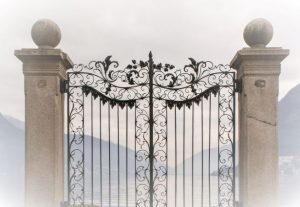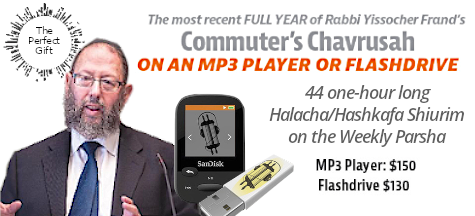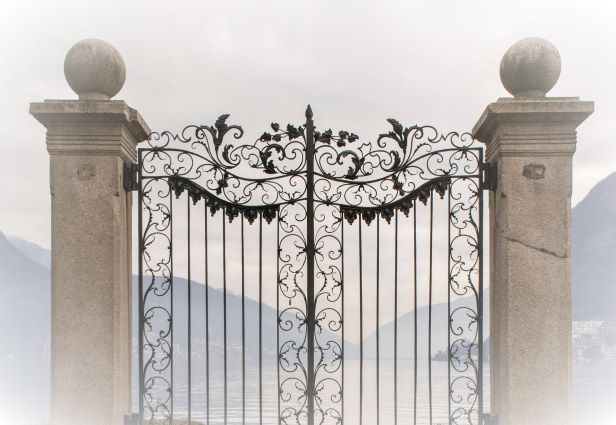

These divrei Torah were adapted from the hashkafa portion of Rabbi Yissocher Frand’s Commuter Chavrusah Tapes on the weekly portion: #1203 – Mesiras Nefesh Challenges From Biblical Times Through the twentieth century. Good Shabbos!
Note: Readers in Eretz Yisroel, who are a parsha ahead, can access a shiur from a prior year by using the archives at https://torah.org/series/ravfrand/ .
Parshas Emor begins with the admonition to the Kohanim not to come into contact—or even to be in the same room—with a dead person, with the exception of his seven immediate blood relatives. Other than that, a Kohen can have nothing to do with death or dead people. The sefer HaKesav v’HaKabbala advances an interesting theory regarding this halacha: Catholic priests (and perhaps priests or ministers from other denominations as well) play an important role in death. The priest administers the “Last Rites.” When a person is on his deathbed, or even after a person has expired, the priest will inevitably be summoned to administer these “Last Rites.”
The theory behind this religious ritual is that somehow the priest can get the dying or deceased individual into Heaven. If someone has this ceremony performed upon him he is, so to speak, “guaranteed to be a son of the World-to-Come.” This means that a person could have lived a life of sin, but as long as he receives the Last Rites, he does not need to worry about “burning in eternal damnation.”
In Judaism, there is no religious functionary who can get anyone into Gan Eden or Olam HaBah – neither a Rav nor a Kohen. The Kohen can bring a Korban for a person, and he can do other things to help a person fulfill certain aspects of Divine Service during his lifetime, but after a person dies, the Kohen has no power to get him into Olam HaBah. Therefore, says the HaKesav v’HaKabbala, the Torah insists on distancing Kohanim from any aspect of death.
In Yiddishkeit, the only person who will get you into Gan Eden or Olam HaBah is you yourself, and you need to earn it while you are alive. After death, it is too late. That is why the Torah placed this fence and obstacle between Kehunah and Tumas HaMes – in order that no one should think that when the time comes, “he’ll get me in.”
The Symbolism of Showing the Show Bread
I found the following thought in the sefer Imrei Baruch from Rabbi Baruch Simon (a rebbe in Yeshivas Rabbeinu Yitzchak Elchanon, Yeshiva University).
This week’s parsha repeats the mitzvah of the Lechem HaPanim, the twelve loaves of ‘Showbread’ that were on the Shulchan in the Mishkan and later in the Beis haMikdash. The Gemara states (Chagiga 26b) that at the end of the three Pilgrimage Festivals when Jews came from all of Eretz Yisrael to the Beis HaMikdash, when they were about to leave, the Kohanim lifted the Shulchan to show the Lechem HaPanim to those who came up for the Regalim.
When they showed the Lechem HaPanim, the Kohanim would say, “See how precious you are before the Almighty – the Lechem HaPanim is still as fresh and warm now when we’re removing it from the Shulchan, a week after being baked, as it was when it was first placed on the Shulchan.” This was a great miracle that occurred week after week with the Lechem HaPanim. It remained warm a week after it was baked!
This was the parting message that the Kohanim delivered to the Pilgrims as they were about to return home after spending the Shalosh Regalim in the proximity of the Beis HaMikdash. Rabbi Baruch Simon comments that there were many miracles that the Ribono shel Olam performed in the Beis HaMikdash. Why was specifically this miracle pointed out and shown off to those who came up to Yerushalayim for the Regalim?
He cites an idea from the Pri Tzadik, Rav Tzadok haKohen of Lublin, that the warmth of the Lechem HaPanim was indicative of how the Ribono shel Olam loves Klal Yisrael. There were twelve Lechem HaPanim, corresponding to the twelve Tribes. When the Almighty kept the twelve Lechem HaPanim warm, He was making the statement “I love you. Our relationship is still warm. It has not dissipated over the past week. And I love all twelve of the Tribes of Israel.”
There is a universal minhag, based in Halacha, that a Beis Knesses has twelve windows. The reason for this practice is that each Tribe has its own “pathway” to the Ribono shel Olam. Contrary to what some people may think, Klal Yisrael is not monolithic. We are not a one-size-fits-all religion where just a single approach to Divine Service is appropriate for all Jews. Every Shevet had its own path to the Almighty, and this was signified in the Beis HaMikdash, where there were twelve windows, and so too it is signified in every shul, which also has twelve windows.
The approach of Shevet Reuven is different from the approach of Shevet Shimon, and the approach of Shevet Gad is different from the approach of Shevet Dan. But, the Lechem HaPanim of all those twelve Tribes is still warm a week after having been taken out of the oven, because the Ribono shel Olam loves the approaches advanced by each of the Tribes. Of course, this is predicated on the fact that they are all done k’Das u’k’Din – based on Torah and Halacha. But there are nuances and differences. We all know that. There is Nussach Sfard and Nussach Ashkenaz. There are Chassidim and Misnagdim. There are different approaches. Every Tribe has its own approach, and they are all dear to the Almighty.
What better message can be imparted to Klal Yisroel as they head back home to their communities where they live together with people who are different, and who may have different approaches. Their approaches are as valid as your approach. That is what will keep us together as a unified nation. When everyone has the affirmation that the approach of each Tribe – as long as it is done k’Din u’k’Das – is precious to the Almighty, then we will have greater Achdus in Klal Yisrael. This is the message that the Olei Regalim are left with as they head back home to their local communities.
This is an important message to keep in mind during the weeks of Sefirah when we observe partial laws of mourning because of the disciples of Rabbi Akiva who died during the period because they did not show proper honor and respect for their fellow Jews. No one should disparage the legitimate approach of his fellow member of Klal Yisrael just because he does things somewhat differently.
Transcribed by David Twersky; Jerusalem [email protected]
Technical Assistance by Dovid Hoffman; Baltimore, MD [email protected]
This week’s write-up is adapted from the hashkafa portion of Rabbi Yissochar Frand’s Commuter Chavrusah Series on the weekly Torah portion. A listing of the halachic portions for Parshas Emor is provided below:
- # 010 – Can Kohanim visit Graves of Tzadikim
- # 053 – Are Our Kohanim Really Kohanim?
- # 096 – “Kovod Habrios”: The Concept of Human Dignity
- # 144 – Kohanim in Hospitals: A Real Problem
- # 191 – The Bracha for Kiddush Hashem.
- # 281 – Kiddush Hashem: Is “Giluy Arayus” Ever Permitted?
- # 327 – The Cohain and the Divorcee
- # 371 – The Mitzvah of Ve’Kidashto: Honoring Kohanim
- # 415 – The Ba’alas Teshuva and the Kohain
- # 459 – Eliyahu Hanavi and the “Dead” Child
- # 503 – Standing Up While Doing Mitzvos
- # 547 – The Wayward Daughter
- # 591 – The Kohain and the Gerusha
- # 635 – Bracha of Mekadaish Es Shimcha B’rabim
- # 679 – Mrs. Cohen is Having A Baby
- # 723 – Is the Kohain Always First?
- # 767 – Kohain, Kaddish, and Kadima
- # 811 – Is Adultery Ever Permitted?
- # 855 – The Brother-in-Law Who Threw Out The Ring
- # 899 – Motrin For Your Children?
- # 944 – Honoring Kohanim – Even Children?
- # 986 – The Child of a Jewish Mother and Non-Jewish Father: Jewish?
- #1030 – The Bonfires of Meiron–When Did it Start? Why? Mutar?
- #1075 – Can I Steal Your Medicine To Save My Life?
- #1117 – Must We Honor Leviim As Well As Kohanim?
- #1159 – The “Morranos” of Spain: Their Halachic Status
- #1203 – Mesiras Nefesh Challenges From Biblical Times Through the twentieth century
- #1248 – The Challenge for the Occupational and Speech Therapist: Feeding Non-Kosher Food to a Jewish Child
- #1291 – The Fascinating Case of the Kohain Who Showed Up In Shul After They Sold The Aliyah to A Yisroel
- #1335 – May We Accept Tzedaka From Non-Jews
A complete catalogue can be ordered from the Yad Yechiel Institute, PO Box 511, Owings Mills MD 21117-0511. Call (410) 358-0416 or e-mail [email protected] or visit http://www.yadyechiel.org/ for further information.


